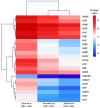Reproductive Toxicity Effects of Phthalates Based on the Hypothalamic-Pituitary-Gonadal Axis: A Priority Control List Construction from Theoretical Methods
- PMID: 40806518
- PMCID: PMC12347981
- DOI: 10.3390/ijms26157389
Reproductive Toxicity Effects of Phthalates Based on the Hypothalamic-Pituitary-Gonadal Axis: A Priority Control List Construction from Theoretical Methods
Abstract
Phthalate esters (PAEs), frequently detected in various environmental media, are associated with multiple health issues, particularly reproductive toxicity. This study employed molecular docking and molecular dynamics simulations to investigate the reproductive toxicity risk of 22 PAEs on the regulation of the hypothalamic-pituitary-gonadal (HPG) axis. Analysis revealed that when the carbon number of PAEs was the same, those with branched side chains exhibited more pronounced reproductive toxicity risks. In PAE molecules with branched side chains, reproductive toxicity risk was inversely proportional to the number of carbon atoms. Furthermore, five PAE molecules with unacceptable risk (DIPRP, DMEP, DMP, DPP, and DUP) and four key indicators were proposed. Key descriptors influencing PAEs' reproductive toxicity risks were identified as Infrared and ATSC8e by machine learning analysis. Furthermore, carbonyl structure, substituent position, and electronegativity of PAE molecules are critical factors influencing PAE-induced reproductive toxicity risks via the HPG axis. This study provides a theoretical basis for further investigation of PAE-induced reproductive toxicity risk on the HPG axis, which facilitates the development of risk mitigation strategies for PAEs' reproductive toxicity and provides novel perspectives and approaches for exploring the molecular mechanisms underlying the endocrine effects of emerging contaminants such as PAEs.
Keywords: adverse outcome pathway; machine learning; molecular dynamics simulation; phthalate esters; priority control list; reproductive toxicity.
Conflict of interest statement
The authors declare no conflict of interest.
Figures






Similar articles
-
Phthalates (PAEs) and reproductive toxicity: Hypothalamic-pituitary-gonadal (HPG) axis aspects.J Hazard Mater. 2023 Oct 5;459:132182. doi: 10.1016/j.jhazmat.2023.132182. Epub 2023 Jul 28. J Hazard Mater. 2023. PMID: 37557049
-
Ecotoxicological effects of phthalate esters: A review.Environ Pollut. 2025 Oct 1;382:126664. doi: 10.1016/j.envpol.2025.126664. Epub 2025 Jun 13. Environ Pollut. 2025. PMID: 40516672 Review.
-
Prescription of Controlled Substances: Benefits and Risks.2025 Jul 6. In: StatPearls [Internet]. Treasure Island (FL): StatPearls Publishing; 2025 Jan–. 2025 Jul 6. In: StatPearls [Internet]. Treasure Island (FL): StatPearls Publishing; 2025 Jan–. PMID: 30726003 Free Books & Documents.
-
Phthalates and their effects on human health: Focus on erythrocytes and the reproductive system.Comp Biochem Physiol C Toxicol Pharmacol. 2023 Aug;270:109645. doi: 10.1016/j.cbpc.2023.109645. Epub 2023 May 5. Comp Biochem Physiol C Toxicol Pharmacol. 2023. PMID: 37149015 Review.
-
A systematic review of global distribution, sources and exposure risk of phthalate esters (PAEs) in indoor dust.J Hazard Mater. 2024 Jun 5;471:134423. doi: 10.1016/j.jhazmat.2024.134423. Epub 2024 Apr 25. J Hazard Mater. 2024. PMID: 38678719
References
-
- Anh H.Q., Nguyen H.M.N., Do T.Q., Tran K.Q., Minh T.B., Tran T.M. Air pollution caused by phthalates and cyclic siloxanes in Hanoi, Vietnam: Levels, distribution characteristics, and implications for inhalation exposure. Sci. Total Environ. 2021;760:143380. doi: 10.1016/j.scitotenv.2020.143380. - DOI - PubMed
MeSH terms
Substances
LinkOut - more resources
Full Text Sources

